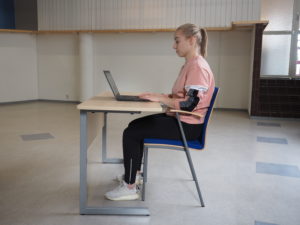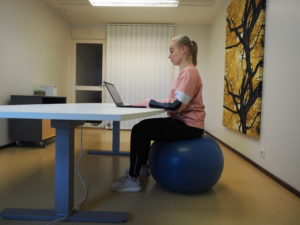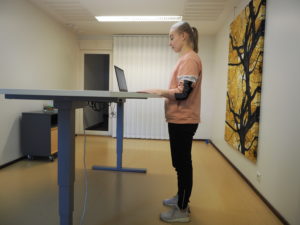In order to ensure good ergonomics when sitting, the chair and the work desk should be adjusted of suitable dimensions so that when writing, shoulders remains relaxed, upper limbs rest against the desk, a good posture of the back is maintained and the feet rest on the floor. From a student’s point of view, the ergonomic challenge is that the school’s facilities are rarely individually adjustable, which would be a basic requirement for good ergonomics. In this case, pauses become even more important.


There are still very few items of furniture designed for studying by standing in schools. It’s also advisable to adjust the height of a desk according to the height of a student. When working at a standing posture, it is good to have the weight of the lower limbs evenly on both of the legs and the body positioned close to the table. The forearms rest casually against the table and the shoulders are relaxed. The head is in line with the back.
It is also important to invest in the ergonomics when studying at home. A good, lumbar-supporting chair is a basic acquisition for a student. If you want to read for an exam on a sofa, it is good to place a pillow behind your lumbar spine to support your back in a good position. The neck and head should be aligned with the back. A pillow and a laptop rack placed on the knees reduces the load on the neck.
You can also try studying at home by standing. A standing work station can be built at home by placing a box on the top of the desk. Various affordable laptop racks have also been developed to enable a good working height. Sometimes it is also appropriate to purchase a separate keyboard if you are working solely on a laptop. A separate keyboard allows sufficient distance to the display, which is approximately the length of the arm forward from the body.


Source: Siekkinen, K. 2019. Opiskeluergonomia – sujuvampaa ja vaivattomampaa opiskelua.
In the book: Kunttu, K. ym. Opiskeluterveys. Duodecim.
